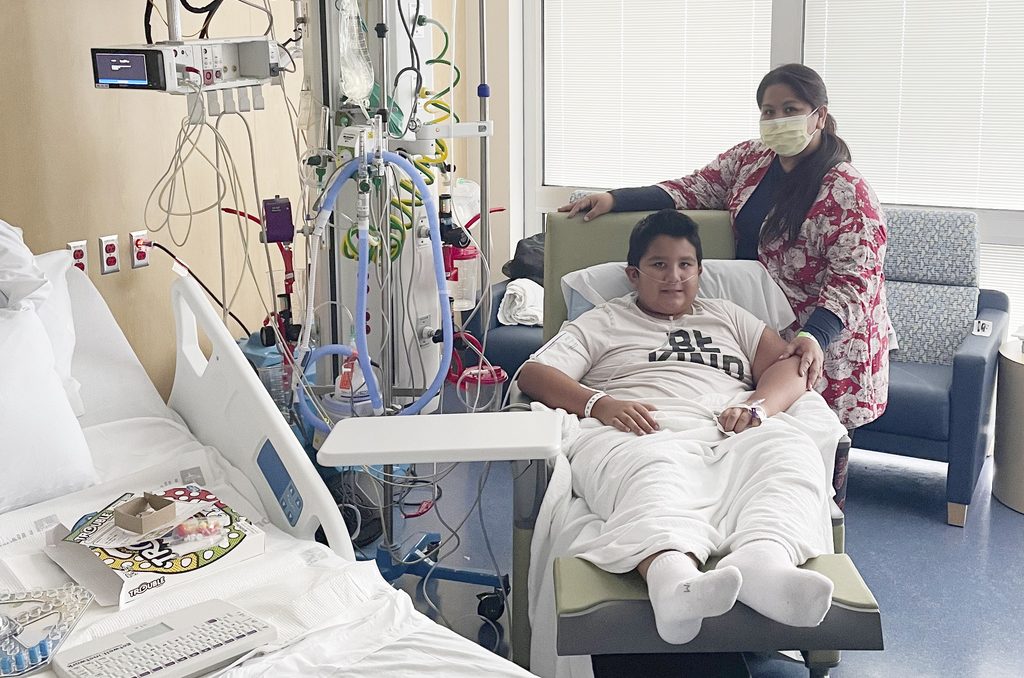
Bay Area pediatricians knew omicron was like nothing they’d seen before for their youngest patients, and a new study released Tuesday confirms their alarm: The highly contagious variant sent kids to U.S. hospitals at rates four times higher than delta, and rates were higher still for those under age 5, who are too young for COVID-19 vaccination.
Although kids have been least vulnerable to the virus, the rise in severe illness among them as cases surged this winter alarmed health officials who have pleaded with parents to get their children vaccinated.
“We all went into pediatrics to make kids better, so seeing them suffer in the hospital and outside, it’s hard,” said Jenna Holmen, a pediatric infectious disease specialist at UCSF Benioff Children’s Hospital Oakland, which was forced to double occupancy in some rooms during the height of the omicron surge.
Tuesday’s report from the Centers for Disease Control and Prevention revealed the youngest children, up to age 4, were especially vulnerable: Hospitalization rates per 100,000 children in that age group were about five times higher during the peak omicron week, at 15.6, than during the delta peak at 2.9.
“Omicron is just a different beast than anything we’ve seen before in terms of volume,” Holmen said.
The study looked at weekly hospitalization rates from July 3, 2021, to January 22, 2022, in 14 states — California, Colorado, Connecticut, Georgia, Iowa, Maryland, Michigan, Minnesota, New Mexico, New York, Ohio, Oregon, Tennessee, and Utah — covering both the delta and omicron variant surges.
It found that hospitalization rates among children under age 18 reached 7.1 per 100,000 during the peak of the omicron case surge in the week ending Jan. 8, nearly four times the peak of 1.8 per 100,000 during the peak of delta cases the week of Sept. 11.
“Coinciding with emerging predominance of the omicron variant, rates of COVID-19-associated hospitalization among children and adolescents increased rapidly during the last two weeks of December 2021, especially among those aged 0-4 years,” the authors noted.
Hospitalization rates rose less sharply in older children, from 1.1 during delta to 2.4 during omicron for kids ages 5-11, and from 1.7 during delta to 5.9 during omicron for kids ages 12-17.
Youth who were unvaccinated in that age group fared much worse: December hospitalization rates among unvaccinated adolescents were about six times those of fully vaccinated adolescents, suggesting the vaccines were highly effective.
Children ages 5-11 were authorized for the vaccines Nov. 2 and by the end of December 16% were fully vaccinated, compared with 54% of those ages 12-17. Authorization of a vaccine for children under 5 was delayed last week after the Food and Drug Administration said it needed more time to review trial results.
“Vaccination of eligible persons, in addition to other prevention strategies such as masking, are critical to reducing the incidence of severe COVID-19 among children and adolescents,” the CDC study said.
Despite the troubling rise in hospitalizations among children, their rates remain far below those of adults, who face progressively higher risk of serious COVID-19 illness as they age.
CDC data show that at the peak of the winter surge last month, the hospitalization rate for adults 18-29 was two and a half times higher than kids under 18. The rate was more than three times higher for adults 30-39, three and a half times higher for adults 40-49, five and a half times higher for adults 50-59, eight and a half times higher for adults 60-69 and 17 times higher for those 70 and older.
Even so, children still can get very sick.
“They are not immune to this disease,” Holmen said.
Pediatricians at hospitals and clinics across the Bay Area are now catching their breath after the worst of the omicron surge, but the lessons they learned nearly two years into the pandemic were powerful: Vaccines are a difference maker.
Dennis Lund, Stanford Children’s Health chief medical officer, believes the Bay Area’s high vaccination rates kept children’s hospitalization numbers manageable locally.
Related Articles
Travel: What it’s like to go on a cruise during the COVID-19 era
Coronavirus: Orange County reported 702 new cases and 18 more deaths, Feb. 15
CDC study links infant protection to COVID vaccination during pregnancy
Disneyland drops mask requirements
Coachella, Stagecoach festivals won’t require COVID-19 vaccination, tests or masks
“There are some children’s hospitals around the U.S. that have been completely inundated,” Lund said in a recent interview. “We’re very fortunate here in California, particularly Northern California.”
He said Stanford’s Lucile Packard Children’s Hospital saw an increase in COVID-19 patients from delta to omicron, but most children admitted tended to be in poor health to begin with, suffering from cancer or heart disease, or having had an organ transplant.
Ranjani Chandramouli, a pediatrician and medical director at the San Jose-based nonprofit Gardner Health Services, noticed an increase in the number of children coming down with omicron, especially among patients younger than 5.
Chandramouli said she was looking forward to being able to vaccinate her youngest patients — not only for protection from future waves or new variants but so they can return to activities some families have avoided during the pandemic.
Related Articles
Travel: What it’s like to go on a cruise during the COVID-19 era
Coronavirus: Orange County reported 702 new cases and 18 more deaths, Feb. 15
CDC study links infant protection to COVID vaccination during pregnancy
Disneyland drops mask requirements
Coachella, Stagecoach festivals won’t require COVID-19 vaccination, tests or masks
“Children want to play. That’s the bottom line,” she said. “Children’s growth and development is all social interaction.”
